
Bunge Church is a medieval church in Bunge on the Swedish island of Gotland. The church seen today was largely built during the 14th century and is in a High Gothic style typical for churches on Gotland. Inside, the church is richly decorated with medieval murals, including depictions of medieval knights whose significance remain contested. Bunge Church belongs to the Church of Sweden and lies in the Diocese of Visby (Sweden).

Fröjel Church is a medieval church in Fröjel on the Swedish island of Gotland. Fröjel Church may have been built to serve not only as a church, but also as a fortification. Stylistically, it is a mix of Romanesque and Gothic architecture, and contains murals from the early 14th century. It is associated with the Diocese of Visby of the Church of Sweden.
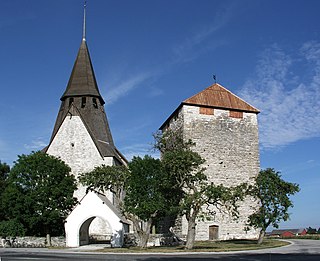
Gammelgarn Church is a medieval church in Gammelgarn on the Swedish island of Gotland. The largely Gothic church stands next to an older defensive tower. The church's main portal is richly decorated with medieval sculpture, and the interior contains an altarpiece from the 14th century of high craftsmanship. The church is in the Diocese of Visby of the Church of Sweden.

Alskog Church is a medieval church in Alskog on the Swedish island of Gotland. The church in its entirety dates from the 13th century, with the last additions probably being made c. 1300. A few alterations are of later date. It contains several medieval furnishings, as well as some medieval stained glass windows. Alskog Church belongs to the Church of Sweden and lies in the Diocese of Visby.

Anga Church is a 13th century church in Anga on the Swedish island of Gotland. It is one of the most well-preserved Romanesque churches on Gotland, and was possibly preceded by a stave church. Inside, the church is decorated with medieval murals from three different periods, as well as some medieval furnishings. Some wooden sculptures from the church are today exhibited in a museum in Visby. The church belongs to the Church of Sweden and lies within the Diocese of Visby.

Alva Church is a medieval church in Alva on the Swedish island of Gotland. The oldest parts of the church date from the late 12th century; with the halted construction of the tower about a century later, building activity ceased. The church contains medieval murals as well as a number of medieval furnishings and pieces of art. It lies in the Diocese of Visby of the Church of Sweden.

Lye Church is a medieval church on Gotland, Sweden. The oldest parts of the church date from the last quarter of the 12th century, and the last major addition was the disproportionately large chancel, built during the second quarter of the 14th century by a workshop known by its notname as Egypticus. The workshop was also responsible for constructing the largest of the church portals, which is also decorated with Gothic stone sculpture. The tower portal contains sculptures attributed to the Romanesque sculptor Sigraf. The church has been little altered since the end of the Middle Ages. Lye Church contains the largest preserved set of medieval stained glass windows in the Nordic countries, and its interior is also decorated by medieval wall paintings, uncovered in the 1950s. The altarpiece is from 1496, and the church also contains a triumphal cross from the same period.
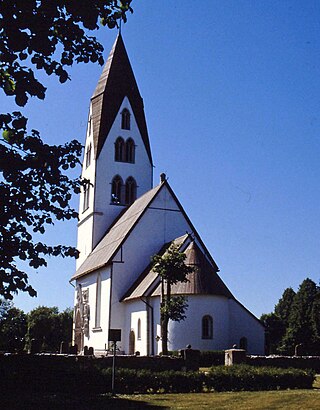
Stånga Church is a medieval church in Stånga on the Swedish island of Gotland. The site of the church has probably been considered sacred since before the Christianization of Scandinavia.

Hemse Church is a medieval Lutheran church in Hemse on the island of Gotland. Preceded by the most well-preserved early stave church discovered in Sweden, the current church dates mainly from the 13th century. It contains sets of medieval murals as well as some medieval furnishings. It is part of the Diocese of Visby.
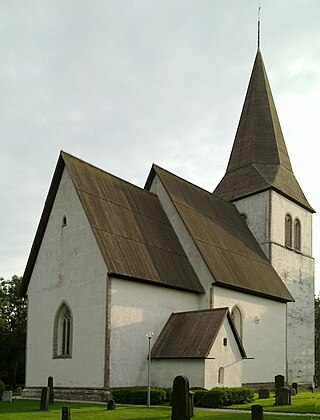
Etelmhem Church is a medieval church on the Swedish island of Gotland. The largely Gothic church contains medieval murals and a 12th-century baptismal font by the sculptor Hegvald. The church is used by the Church of Sweden and part of Diocese of Visby.

Barlingbo Church is a medieval church in Barlingbo on the Swedish island of Gotland. It dates from the 13th century and has been altered little since. It contains furnishings from several centuries, including an unusual medieval baptismal font, decorated with figures and runes. The church belongs to the Church of Sweden and lies in the Diocese of Visby.

Buttle Church is a medieval church in Buttle on the Swedish island of Gotland. It is one of the more well-preserved Romanesque churches on Gotland, and contains both a number of medieval furnishings as well medieval murals. Buttle Church belongs to the Diocese of Visby of the Church of Sweden.
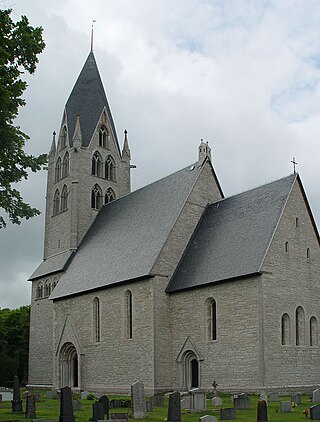
Dalhem Church is a medieval church in Dalhem on the Swedish island of Gotland. Built in the 13th and 14th century, the church underwent major changes during a renovation at the turn of the 19th–20th centuries. Dalhem Church lies in the Diocese of Visby of the Church of Sweden.

Ekeby Church is a medieval church in Ekeby on the Swedish island of Gotland. The oldest parts date from the 12th century, and the church has been little altered since the end of the 13th century. Its interior is richly decorated with medieval murals. It belongs to the Church of Sweden and lies in the Diocese of Visby.

Linde Church is a medieval church on the Swedish island of Gotland. The church was built between the 12th and the early 13th century and is Romanesque in style. I lies in the Diocese of Visby.
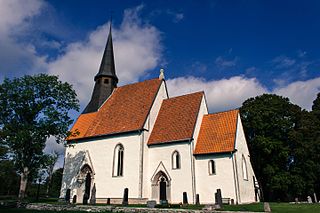
Kräklingbo Church is a medieval church in Kräklingbo on the Swedish island of Gotland. It belongs to the Diocese of Visby.
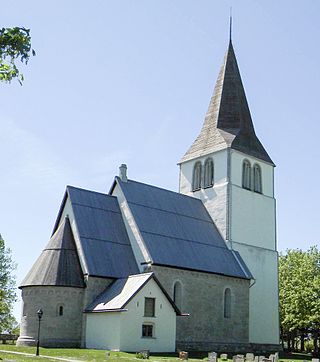
Levide Church is a medieval church on the Swedish island of Gotland. It lies in the Diocese of Visby.

Lojsta Church is a medieval church in Lojsta on the Swedish island of Gotland. The well-preserved church contains several sets of medieval murals. It belongs to the Diocese of Visby within the Church of Sweden.

Lummelunda Church is a medieval church in Lummelunda on the Swedish island of Gotland. The oldest parts were built circa 1200, and the last major alterations made in the 14th century when a new choir was built. It belongs to the Diocese of Visby.





















